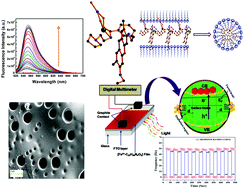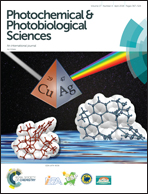A turn-on fluorogenic chemosensor for Fe3+ and a Schottky barrier diode with frequency-switching device applications†
Abstract
A novel highly sensitive and selective fluorescent chemosensor L has been synthesized and characterized by various physicochemical techniques. In 3 : 7 water : MeCN (v/v) at pH 7.2 (10 mM HEPES buffer, μ = 0.05 M LiCl), it selectively recognizes Fe3+ through 1 : 1 complexation resulting in a 106-fold fluorescence enhancement and a binding constant of 8.10 × 104 M−1. The otherwise non-fluorescent spirolactam form of the probe results a dual-channel (absorbance and fluorescence) recognition of Fe3+via CHEF (chelation enhanced fluorescence) through the opening of the spirolactam ring. We have also carried out fluorescence titration and anisotropy (r) studies in pure water in the presence of SDS (sodium dodecyl sulphate). Based on the dependence of FI (fluorescence intensity) and r on [SDS] it was proposed that the probe is trapped between two SDS monolayers which again interact among themselves by π⋯π stacking. As a result, there is an increase in FI up to [SDS] ∼ 7 mM – a phenomenon reminiscent of aggregation-induced enhancement of emission (AIEE). Beyond this concentration of SDS (7 mM), micelle formation takes place and the π⋯π stacked polymer now becomes a monomer and is trapped inside the micellar cavity. As a result, there is a decrease in FI at [SDS] > 7 mM. But for anisotropy, it increases with [SDS] beyond 7 mM. Ligand, metal, and SDS interactions are well established through different optical and morphological studies. [L–Fe(NO3)]2+ thin films on FTO (Fluorine-doped Tin Oxide) glass substrates have been designed with the help of the spin-coating deposition technique. The deposited film of thickness 1.6 × 10−5 cm is well characterized by optical band gap calculation with a direct band gap, εg ∼ 1.6 eV. FESEM was also performed for the [L–Fe(NO3)]2+/FTO film. The current–voltage characteristics were measured by the two-probe technique. Light-dependent exciton generation was carried out by taking the top and bottom contacts with graphite paste on FTO and on the [L–Fe(NO3)]2+ films for the measurement of switching behavior. The response ratio curve for the light-induced frequency-switching phenomena has been obtained. The frequency taped here is the oscillation frequency of the photo-generated electron and the hole in an exiton. Thus, the light-induced frequency-switching behavior and Schottky barrier diode characteristics of the material were established.



 Please wait while we load your content...
Please wait while we load your content...